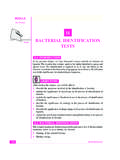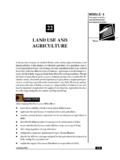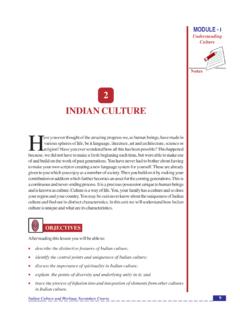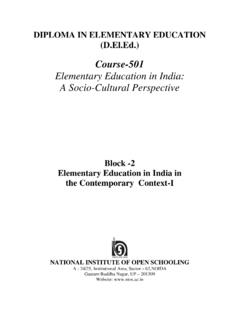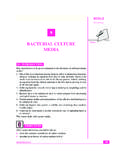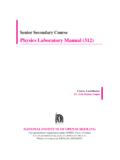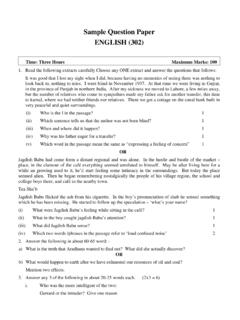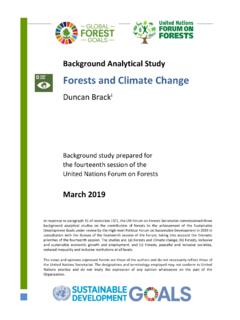Transcription of 19 CLASSIFCATION OF LIVING ORGANISMS
1 MODULE - 5 The LIVING World 1 Classification of LIVING organismsSCIENCE AND TECHNOLOGYN otes19 CLASSIFCATION OF LIVINGORGANISMSDo you know that earth is the only planet in our solar system of eight planets on which life exists; LIVING ORGANISMS derive most of their requirements for survival from the non livingsources of earth; every organism begins life as a single cell; there are plants which eat insects; mushrooms that we relish as vegetarian food are fungi. Fungi are the group oforganisms which subsist on dead and decaying matter; certain bacteria live in oceanic vents at temperatures as high as 80 C to 110 the temperature at which you feel uncomfortable on a sunny summer day or an icycold winter night and it will give you an idea of how high the temperature is at which thesebacteria lesson deals with the diverse kinds of ORGANISMS found on earth and the ways andmeans of studying this vast biodiversity.
2 It also emphasizes the need for conservation completing this lesson, you will be able to: recognize the vast diversity of LIVING ORGANISMS in terms of variety of size andcomplexity; explain the meaning of biodiversity; describe the levels of biodiversity;SCIENCE AND TECHNOLOGYMODULE - 5 Classification of LIVING organismsThe LIVING World 2 Notes appreciate the need for classification of LIVING ORGANISMS ; justify the rationale underlying the five kingdom classification and thehierarchy in classification of LIVING ORGANISMS ; argue in favour of binomial nomenclature with examples; classify kingdom Plantae upto division; kingdom Animalia upto phyla andthe chordates upto classes; become aware of and take steps towards conserving What is biodiversityWe find LIVING ORGANISMS all around us, even deep under the oceans and in thesnow covered Arctic and Antarctica. There are ORGANISMS which are single celledand microscopic, as well as animals as large as the elephant, the rhinoceros, thehippopotamus and the whale.
3 Have you seen the movie Jurassic Park by StevenSpielberg? From the movie you get an idea of how huge the dinosaurs were whichroamed the earth millions of years ago and then became extinct. Also if you were to takea drop of water from the nearby pond and view it under a lens you will be amazed tosee the enormous variety of ORGANISMS moving about in that drop of water. You mightbe wondering how many kinds of ORGANISMS there would be on earth! It is estimated thatabout 10 to 15 million different kinds of ORGANISMS have been found on earth includingthe ones that lived in the past. However, scientists have till date identified only over twomillion of enormous variety of ORGANISMS is termed biodiversity (bios means life anddiversity means variety). There is not only diversity in size among ORGANISMS but also incomplexity. eg. bacteria are simple single celled ORGANISMS and humans are made of atrillion cells and are highly ORGANISMS have come to exist on earth because of evolution and are related throughancestry.
4 You shall learn about evolution and its mechanism in the next (Lesson 20)entitled History of Life on Earth . The humans are at the top of the evolutionary is sad that lots of different kinds of ORGANISMS have been lost due to the impact of humanactivities. Therefore, we have to be conscious and aware so that damage to the earthon which we live along with other ORGANISMS , is you are a stamp collector, make an album or chart of stamps on animals and - 5 The LIVING World 3 Classification of LIVING organismsSCIENCE AND TECHNOLOGYN otesACTIVITY calendars are based on birds or wild animals. Collect the pictures from oldcalendars and make a scrap from variety of size and complexity, there is diversity in modes of feeding,reproduction and other body functions among flow charts by using terms given below in brackets for diversity inreproduction and respiration.
5 Diversity in feeding is given below as a sample:Nutrition(Feeding)AutotrophicFood preparedfrom inorganic rawmaterialHeterotrophicFood from otherorganismsChemotropicEnergy fromchemicalprocesses usedto prepare certainbacteriaPhototrophicSolar energytrapped Most on deaddecayingmatter fooddigested bacteria,fungi, plantsanimals.(Round worm)head the words given below to draw flow charts like the one given above depictingvariety in reproduction and : Asexual, sexual, single parent, two : Oxygen from water, oxygen from atmosphere, Carbon dioxide intowater, into atmosphere, gills, lungs, anaerobic, may seek help of your friends and use other innovative ways of presenting the live up to 8 km in air and up to 5 km below sea level. This part of the earthwhich supports life is the biosphere. Biosphere has diverse ecosystems such as theSCIENCE AND TECHNOLOGYMODULE - 5 Classification of LIVING organismsThe LIVING World 4 Notespond, river, oceans, and mountains, deserts etc.
6 Various kinds of ORGANISMS or differentspecies live in these ecosystems. They interact with each other and also interac with thephysical components of the ecosystem such as light, temperature the following table and perform the accompanying Biosphere, ecosystem and speciesLevel of Organisation Images/ pictures of each level D ivers it y o f features Activity Biosphere the p h ysi cal par t o f eart h on which or g anis m s can survive Fig. Earth as seen from space Oceans, mountains, fresh water bodies, forest s, snow clad areas, des erts and gr as slan ds . Obtain an outline map of the world and mark in different colours, the diverse components mentioned in the adj acent column. Ecosystem Defi nit e geographical region in which various species of or g anis m s liv e and interact wi th each other and the ph ys ical environment Ecosystem Oceans, mountains, rivers, ponds, forests, snow-cl ad areas, deserts etc.
7 Collect pictures or read from your geography book or see a website to rec or d s pecif ic feat ures of t he ecosystems mentioned in the previous column. Species Group of very similar organi sms whic h can interbreed to pr o d uce f ert ile offspring. Fig. Sp ecies Different kinds of bacteria, prot ozoa, fungi, plants and ani mal s Collect pictures of hu m ans belo n gi ng to different parts of the world. They look different. Why are they said to belong to t he same species? Levels of biodiversityAll the varieties of LIVING ORGANISMS on earth constitute biodiversity. Three levels ofbiodiversity have been diversityOrganisms evolved features which helped them adapt to their surroundings or theecosystems in which they live. There are different ecosystems and even relatedorganisms LIVING in different ecosystems may differ vastly from each other. ForMODULE - 5 The LIVING World 5 Classification of LIVING organismsSCIENCE AND TECHNOLOGYN otesexample tortoises are terrestrial and turtles are aquatic.
8 Both are related but differ muchespecially in their feet. There is diversity of ecosystems terrestrial ecosystemsinclude forests, plains, deserts and mountains and aquatic ecosystems are sea, river,pond etc. ORGANISMS LIVING in these have evolved suitable adaptations. India has verydiverse terrestrial and aquatic diversityVariety of species LIVING in a certain geographical area constitutes speciesdiversity. Individual ORGANISMS belonging to a particular species are similarand are able to undergo reproduction to produce fertile offspring. They cannotinterbreed with another species. There is an enormous number of species oforganisms as you have already learnt. It refers to the variety of genescontained within species of plants, animals and microorganisms. Can you sayhow new variations arise in an individual? diversityOrganisms are made of cells andcells in their nuclei containchromosomes which bear thegenes.
9 Genes control the featuresof a particular species. Genes ofindividuals belonging to the samespecies are similar. Every specieshas a gene pool. Gene pool meansall the different kinds of genesfound in a species. The gene poolof a species differs from that ofanother a chart or flash cards or an album or a power point presentation to depict thethree levels of biodiversity. You may use pictures, photocopies of illustrations, photographs,drawings, scanned pictures/photographs may even make a model showing various levels of Patterns of biodiversityGlobal ScenarioThe entire world is divided into six biogeographic regions (Fig. ). The organismsfound in these regions are adapted to the climate of these regions. Certain kinds Levels of biodiversitySCIENCE AND TECHNOLOGYMODULE - 5 Classification of LIVING organismsThe LIVING World 6 Notesorganisms are common to all regions while some are restricted to certain regions elephants are found only in Asia and Africa and nowhere else in the world.
10 Grassis found all over the The six biogeographic regionsIndian SceneIndia has two biodiversity hotspots the Western Ghats and North Eastern regions(including Eastern Himalayas). ( ) Hotspots are regions of the worldwhere many different kinds of ORGANISMS live. Many of these ORGANISMS are notfound elsewhere Many species of frogs live only in the Western Ghats of flora and fauna are our heritage. We must conserve our Biodiversity Hotspots of IndiaINTEXT QUESTIONS does biodiversity mean?_____MODULE - 5 The LIVING World 7 Classification of LIVING organismsSCIENCE AND (i) species, (ii) biosphere (iii) the three levels of is meant by biodiversity hotspots? AND NAMING ORGANISMSHow may this enormous diversity of LIVING beings be studied and comprehended? Thisriddle has been solved by categorising diverse kinds of ORGANISMS and providing themwith scientific of organismsYou have already learnt that about 10-15 million species are supposed to have evolvedon the earth till and calculate how much 10 million would be by adding zeroes after 10.
